6 min read 🤓
Mal-là--colisé dans l'espace et dans le temps (L’i-m-a-g-e E-s-t U-n O-b-j-e-t E-l-a-s-t-i-q-u-e, pt. 1)
april 14, 2015.
du flâneur et de l'homme sandwich
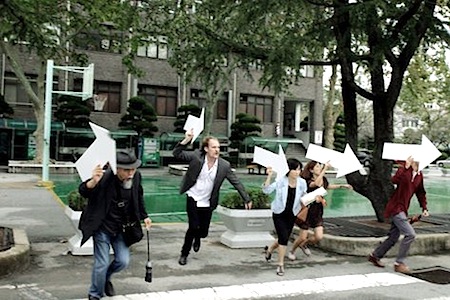
"How many healthy snakes are made with x number of sounds?" The constants are the answers; the keyboard pulses numbers, the interactive brain: la possibilité de filtrer directement les impulsions sur le clavier cerveau interactive.
The elasticity of the image as an object was the fil conducteur of a series of three events proposed by Nadège Derderian. Two of them, on Tuesday March 24th and Sunday March 29th, were part of the expiration of Friches et Nous La Paix, a small gallery - sweet and alternative - in the rue Denoyez in Paris-Belleville. The third was in the afternoon of Easter Saturday, April 4th, at La Générale Nord-Est, followed - with doors closed - by our 16th unPublic.
For the first evening, focusing on mal-localisation in space-time, Namhee Kwon (illegal Buddhist teacher) and myself (aspiring illegal Buddhist monk) joined Rébus, who had come to the Friches with a giant flight case filled to the rim with a (small) part of his ever growing collection of (mainly vintage and in many cases moreover found and/or bent & customized) sonic, sounding and sonifying objects.
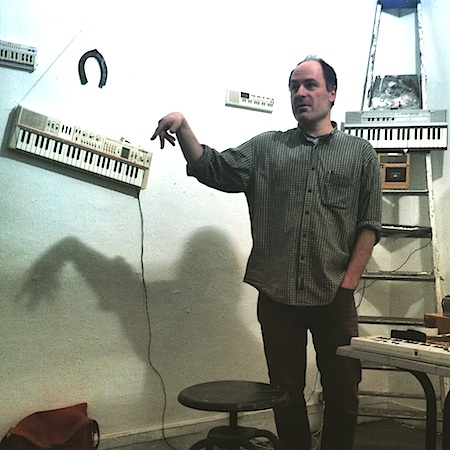
This time the core was a veritable army of 'toy' keyboards - Casio, Yamaha, Bontempi etc., dating from late 1970's to the early 1990's - with which he decorated the gallery space.
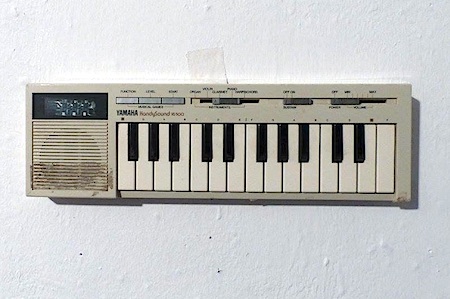 |
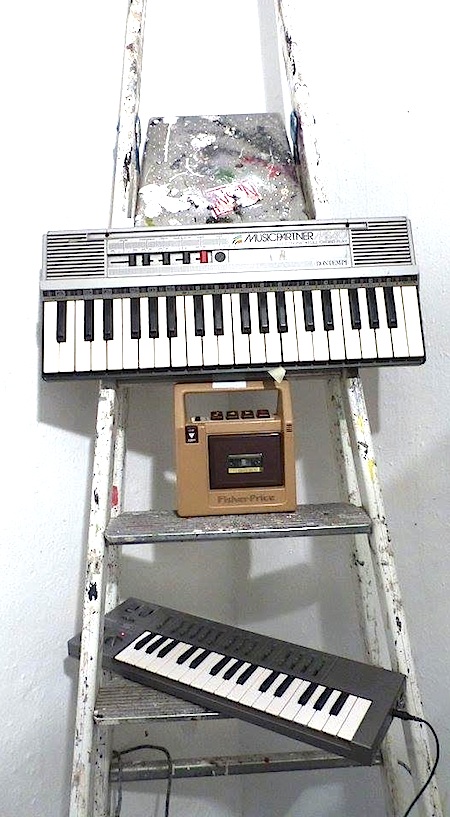 |
Rébus put the little machines to work in his Casiology, a variation on Orguanisation, an installation we did for the Sonic Protest Festival nine years ago, in 2006. In Orguanisation the keyboards were bigger, more of the 'home organ'-type. There were a dozen or so of them, all electronic (transistor) organs, with built in loudspeaker. We had them lined up along the walls of the SP exposition place, and, over a period of 4 hours, using bits of scotch and little pieces of cardboard, 'installed' note by note C major chords over all octaves and all organs, which we then, again note by note and very gradually, transformed into C minors.
This time there were no chords.
There was just this single note:
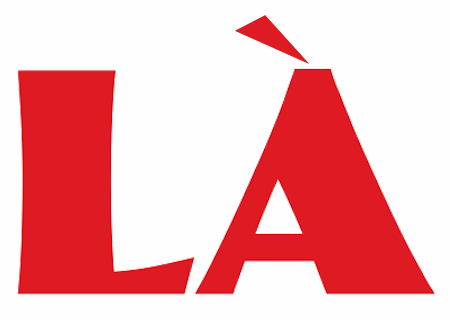
The short strips of scotch now were used to, one by one, activate the la/A's on all of these little keyboards. Played back through the small built-in loudspeaker of the little organs, it filled the Friches's space, not with a cloud of sound, but with something closer to a haze, to a mist, to a brume. A la-ish sonic fog, non-localized within the space-time frame of the small gallery space. It was a fine, be it metaphorical, illustration of the evenings parenthetical theme, inspired by the Fourier uncertainty principle, which implies a time-frequency tradeoff for sound signals and imposes certain limits on the precision of the simultaneous measurement of the duration and the frequency of a sound, much like the position-momentum tradeoff known from quantum mechanics as the Heisenberg uncertainty principle.
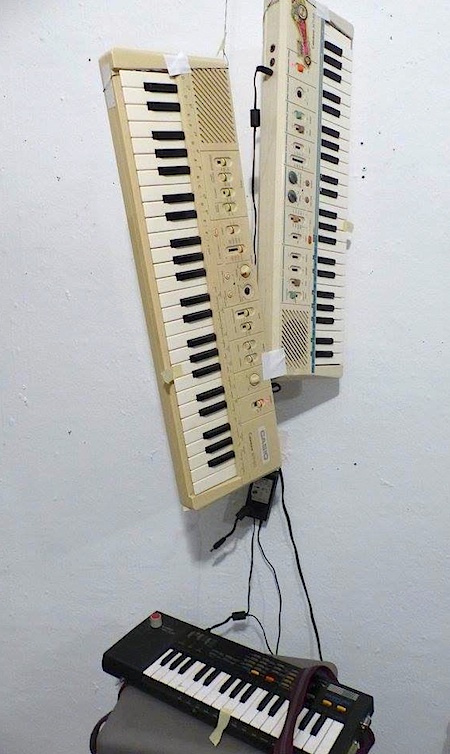
Technically, the haziness of the wonderfully floating unisono LA, tutti that filled the Friches had other causes, a number of them, though in the present case they hardly included the practical impossibility for human performers to maintain a perfect, an ideal, unison. Which was what made the Italian Renaissance music theorist and composer Gioseffo Zarlino (1517-1590) compare it to the point in geometry. Like a point, Zarlino deemed the unison 'incapable of extension'.
At the time that the Casio's, the Bontempi, the Yamaha's etc. left the factory, several decades ago, all of them undoubtedly were tuned to the 'international standard concert pitch', which sets the A above middle C (the 'A4') to 440 Hertz. So in theory, playing all the small instruments' A's simultaneously should give rise a thickish unisono la-field. But then, even the tiniest deviations in frequency will result in the acoustic effects of 'chorus' and 'beats', that you surely are familiar with. And the wear of decades will have been the main reason for the fact that the frequency deviations between the little little keyboards' A's were plenty and varied, which - enhanced by the toys' dispersion over the galery's space - resulted in a fascinating sonic playfield, to walk through and devour.
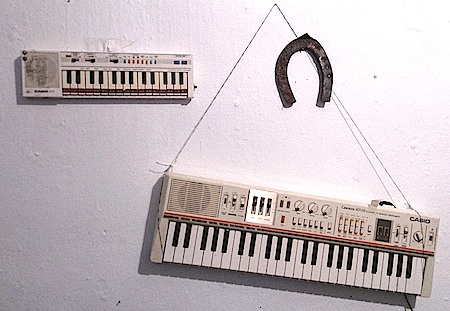
The story of our A's frequency is a fascinating one in and by itself. It seems to be pretty well summarized in this short (pdf) note, by Lynn Cavanagh, who tells us that, prior to 1600, the pitch of a German organ's A "is thought to have varied from a high of 567 Hz for the first simple pipe organs of the Middle Ages to a low of 377 Hz for the early modern organ of around 1511". Baroque composer George Frederic Handel preferred his A to ring at 423, while Mozart did his playing at 422. That is, both, "approximately one half semi-tone lower than our current A". It is interesting to learn that the reasons for the gradual raising of the concert pitch that eventually led to our 440 standard at heart were not very different from those of contemporary record producers to compress and pump up the volume: it was all just a matter of "sounding more brilliant than the competition", of hitting your audiences harder. Apparently (Wikipedia says so [ * ]) the A at La Scala in Milan at times rose as high as 451 :-) ...
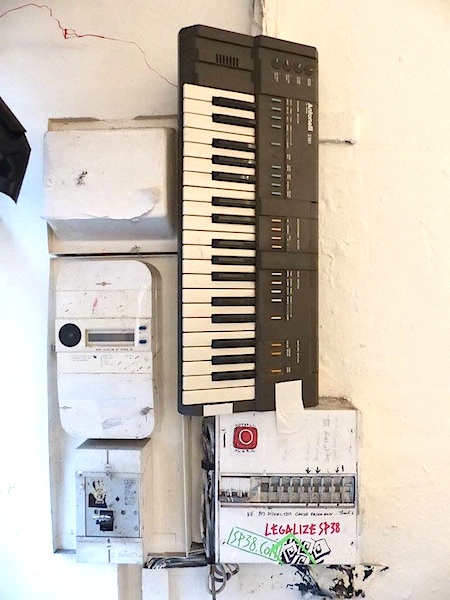
We also did a few simple experiments at the Friches, using as our tools things that in this current day and age are so abundantly available, like Jonathan Liljedahl's very basic The Oscillator iPad application, which comes with two oscillators, which makes it a perfect tool to compare pitches and generate beats in a very precise manner. So we listened for a while to our contemporary standard, 440, and then compared it to 432, a frequency that I often see mentioned, in different context, as an alternative for our standard diapason that would provide a calmer and less harsh sonic texture to much of performed music. Audible lower it is, of course, very much so; but most of the motivation and claims of 'naturalness' are of a decidedly 'meta-mystical' kind.

Indeed, it was Rébus who suggested that there is one other, obvious, alternative for both the standard 440 and its mystic cousin 432. That is why, when, in steps of centiHertzes, that evening in the Friches we gradually brought down one of the oscillator's frequencies from 440, we stopped just short of 432, at what in these post-digital days conceptually seems to be the only correct concert pitch standard. We stopped at:
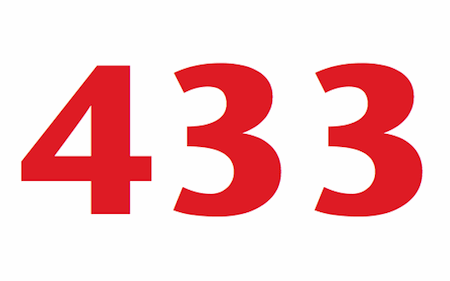
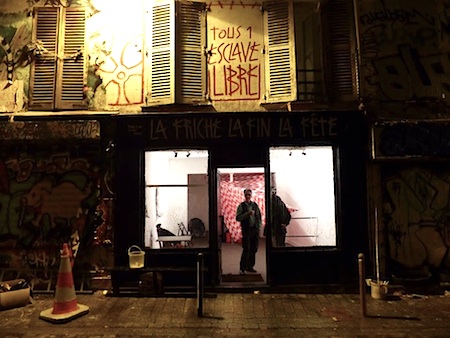
La Générale, April 4th 2015 ... more Casiological Orguanisation
On Easter Saturday, April 4th, Rébus's collection of toy organs played again, during the 3rd and final part of Nadège's L’i-m-a-g-e E-s-t U-n O-b-j-e-t E-l-a-s-t-i-q-u-e-events, at La Générale. This time the little machines were placed on a table, that allowed you to circumscribe the haze of sounds in silent contemplation.
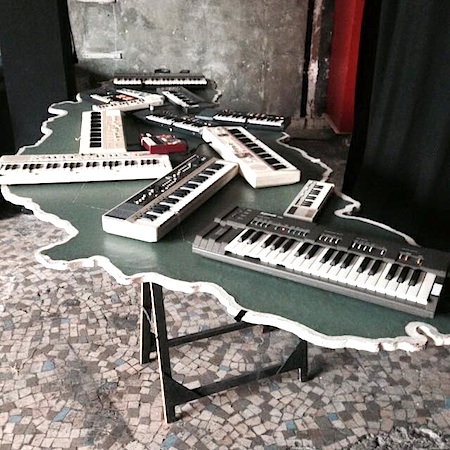
Here is Rébus's video résumé of his Casiology-project:
Rébus's Casiological (Toy)Orguanisation provided the diapason for the unPublic that immediately followed the après-midi élastique. You can hear it loudly and clearly during the first few minutes of that 16th unPublic's recording, though obviously when - as was the case - taken from one single point of (h)ear, almost all of the spatial dynamics and variability in its sounding is 'lost in registration' ...
[ The next SB- entry is Elastic Lecture Nr. 2 (for Namhee). It was my contribution to the 3rd and final part of Nadège's L’i-m-a-g-e E-s-t U-n O-b-j-e-t E-l-a-s-t-i-q-u-e-events, at La Générale, on Easter Saturday April 4th 2015. ]
Read about unPublic on the SoundBlog:
(2023, november 3-..) - Ethereal Reverberations. A Decade of unPublic (« Dix ans qu'on fait la musique sans public ») (uP#100)
(2023, august 20) - Three days of residency at Les Ateliers Claus, Brussels (uP#65, uP#93, up #94)
(2022, september 2) - Three Musketeers Musicking Maastricht & La Générale (uP#86, up #87)
(2022, august 4) - Berlin: Zero Cohesion (3) (uP#84)
(2022, july 24) - Berlin: Zero Cohesion (2) (uP#83)
(2022, july 11) - Berlin: Zero Cohesion (1) (uP#82)
(2022, july 2) - X-unPub (uP#81)
(2022, march 13) - "Manifeste" (uP#80)
(2021, june 13) - Die Stillgestandenen (The Stillstands / Standstills / Stillstanders) (uP#67)
(2021, may 02) - Playing Apart Together: Chuncheon↯Paris (uP#73)
(2018, november 02) - "Five years stuck on my eyes" (Lustrum Non Publicum) (uP#56)
(2018, september 01) - t'Obsolete or not t'Obsolete ... [iv] (uP#54)
(2018, august 13) - Rage, rafts & refugees (uP#49, uP#50)
(2018, august 10) - t'Obsolete or not t'Obsolete ... [iii] (uP#45)
(2017, june 11) - Moving out, of, on ... [ii] (uP#42)
(2016, june 10) - unPublic #18 - 대부도 (Daebu-Do), 14 June 2015 (uP#18)
(2016, may 07) - In Praise of Slowness (uP#21)
(2015, july 15) - Bridges, troubles, water (uP#19)
(2015, april 14) - Mal-là--colisé dans l'espace et dans le temps (uP#16)
(2014, august 02) - Appearance and Reality (uP#8)
(2014, march 08) - "12 - 11 - 9 - 10 - 3 - 6 - 7 - 1 - 2 - 8 - 4 - 5" (uP#5)
(2013, december 31) - Candles, Cassettes & Champagne (uP#4)
(2013, november 23) - unPublic 1, 2 (sauf riverains) (uP#1, uP#2)
Read about unPublic on Medium:
April 16, 2022 - Playing Apart Together (uP#66-#69)
March 17, 2022 - All delusion is expansive (uP#80)
November 10, 2021 - The Future always was Yesterday
Read about unPublic in Gonzo (Circus) [Dutch]:
Gonzo #143, januari/februari 2018 - Met kop noch staart: muzhakdag! (uP#48)
Gonzo #139, mei/juni 2017 - De waan, de wil, de weg
Read about unPublic elsewhere:
Plus-X-Creative, january 2022 - Playing Apart Together
Electronic Cottage, november 2018 - unPublic - 'Five Years stuck on my eyes' -sketch as a memoire
To listen, download & support, visit unPublic @ Bandcamp.
notes __ ::
(*) In its 'concert pitch' lemma, retrieved April 13th, 2015 [
^ ]
tags: uncertainty, concert pitch, tuning standard, unpublic
# .459.
comments for Mal-la--colise dans l'espace et dans le temps ::
|
Comments are disabled |